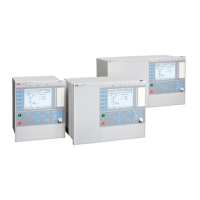10. Wait for a time corresponding to tDelayToAlarm1 from the appearance of
WARNING1 signal. Make sure that the ALARM1 signal appears.
11. Note the time taken for the appearance of ALARM1 signal from the appearance of
WARNING1 signal, and compare it with set value (tDelayToAlarm1).
12. Wait for a time corresponding to tDelayToAlarm2 from the appearance of
WARNING2 signal, and make sure that the ALARM2 signal appears.
13. Note the time taken for the appearance of ALARM2 signal from the appearance of
WARNING2 signal, and compare it with set value (tDelayToAlarm2).
14. Activate the BLKWRN binary input. The WARNING1 and WARNING2 signals
should disappear.
15. Activate the BLKALM binary input. The ALARM1 and ALARM2 signals should
disappear.
16. Reset the BLKWRN and BLKALM binary inputs. Once again warning and alarm
signals should appear.
17. Reduce the three-phase currents suddenly to value lower than the rated current and
take note of hot spot temperature.
18. Check the warnings reset limit (HystAbsHPT). Monitor the WARNING1 and
WARNING2 signals until they disappears on the corresponding binary outputs.
Take the HPTMPMAX readings and compare with the reset level settings.
Verifying LOLINDAY and LOLINYRS outputs
1. Connect the test set for injection of three-phase currents to the appropriate current
terminals of the IED.
2. Make sure that the settings in the IED are appropriate, especially set the EnaAgeCalc
setting as Enable, TimeToUpdate setting as 1 hour and AgeingRateMeth setting as
IEC.
3. Activate the TOTVALID input and set some temperature value in TOTEMP input.
4. Supply the IED with three-phase currents slightly more than the rated value.
5. Note the hot spot temperature (HPTMPMAX) and maintain it for another 1 hour.
6. Check the LOLINDAY and LOLINYRS outputs after 1 hour and compare it with the
calculated loss of life value using IEC standard method.
11.13.6.2 Completing the test
Continue to test another function or end the test by changing the Test mode setting to
Disabled. Restore connections and settings to their original values, if they were changed
for testing purposes.
Section 11 1MRK 504 165-UUS -
Testing functionality by secondary injection
280 Transformer protection RET670 2.2 ANSI
Commissioning manual

